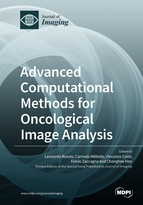Advanced Computational Methods for Oncological Image Analysis
A special issue of Journal of Imaging (ISSN 2313-433X). This special issue belongs to the section "Medical Imaging".
Deadline for manuscript submissions: closed (31 July 2021) | Viewed by 55719
Special Issue Editors
Interests: biomedical image analysis; radiogenomics; machine learning; computational Intelligence; high-performance computing
Special Issues, Collections and Topics in MDPI journals
Interests: biomedical image analysis; radiomics; machine learning; digital architectures; biometrics; hardware programmable devices
Special Issues, Collections and Topics in MDPI journals
Interests: biometric recognition systems; bio-inspired processing systems; medical diagnosis support
Special Issues, Collections and Topics in MDPI journals
Interests: biomedical image analysis; radiomics; machine learning; neuroimaging; neuro-oncology; metabolic imaging
Special Issue Information
Dear Colleagues,
Cancer is the second most common cause of death worldwide and encompasses highly variable clinical and biological scenarios. Some of the current challenge clinical challenges are (i) early diagnosis of the disease and (ii) precision medicine, which allows for treatments targeted to the specific clinical cases. The ultimate goal is to optimize the clinical workflow by combining accurate diagnosis with the most suitable therapies. Towards this, large-scale machine learning research can define associations among clinical, imaging, and multi-omics studies. This methodology provides reliable diagnostic and prognostic biomarkers for precision oncology.
Such reliable computer-assisted methods (i.e., artificial intelligence) together with clinicians’ unique knowledge can be used to properly handle typical issues in evaluation/quantification procedures (i.e., operator-dependence and time-consuming tasks). These technical advances can significantly improve result repeatability in disease diagnosis and guide towards appropriate cancer care. Indeed, the need for applying machine learning and computational intelligence techniques has steadily increased to effectively perform image processing operations – such as segmentation, co-registration, classification, and dimensionality reduction – and multi-omics data integration.
This Special Issue will provide a forum to publish original research papers covering state-of-the-art and novel algorithms, methodologies, and applications of computational methods for oncological image analysis, ranging from radiogenomics to deep learning.
Dr. Leonardo Rundo
Dr. Carmelo Militello
Dr. Vincenzo Conti
Dr. Fulvio Zaccagna
Dr. Changhee Han
Guest Editors
Manuscript Submission Information
Manuscripts should be submitted online at www.mdpi.com by registering and logging in to this website. Once you are registered, click here to go to the submission form. Manuscripts can be submitted until the deadline. All submissions that pass pre-check are peer-reviewed. Accepted papers will be published continuously in the journal (as soon as accepted) and will be listed together on the special issue website. Research articles, review articles as well as short communications are invited. For planned papers, a title and short abstract (about 100 words) can be sent to the Editorial Office for announcement on this website.
Submitted manuscripts should not have been published previously, nor be under consideration for publication elsewhere (except conference proceedings papers). All manuscripts are thoroughly refereed through a single-blind peer-review process. A guide for authors and other relevant information for submission of manuscripts is available on the Instructions for Authors page. Journal of Imaging is an international peer-reviewed open access monthly journal published by MDPI.
Please visit the Instructions for Authors page before submitting a manuscript. The Article Processing Charge (APC) for publication in this open access journal is 1800 CHF (Swiss Francs). Submitted papers should be well formatted and use good English. Authors may use MDPI's English editing service prior to publication or during author revisions.
Keywords
- biomedical image analysis and processing
- oncological imaging
- computer-assisted tumor detection and segmentation
- tumor classification
- therapy response prediction
- radiomics
- radiogenomics
- artificial intelligence
- applied machine learning
- precision medicine











